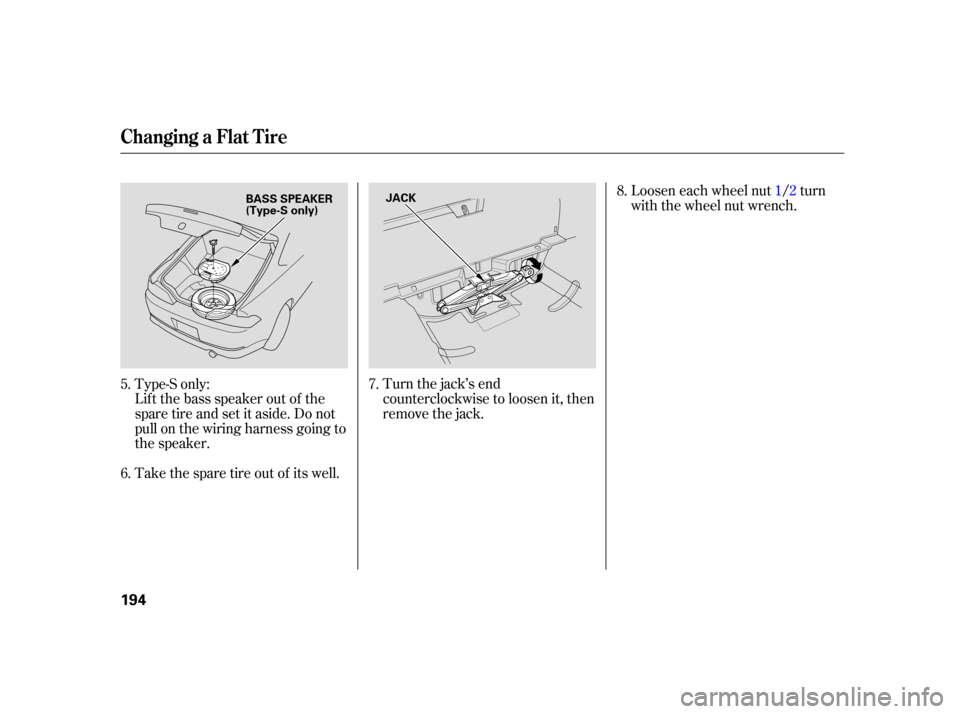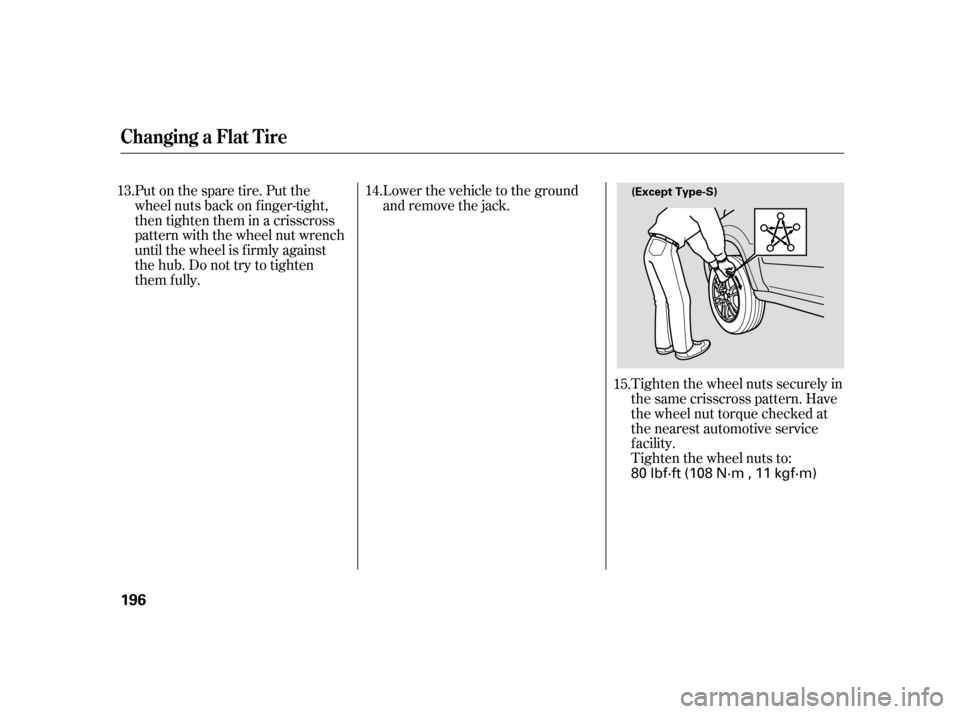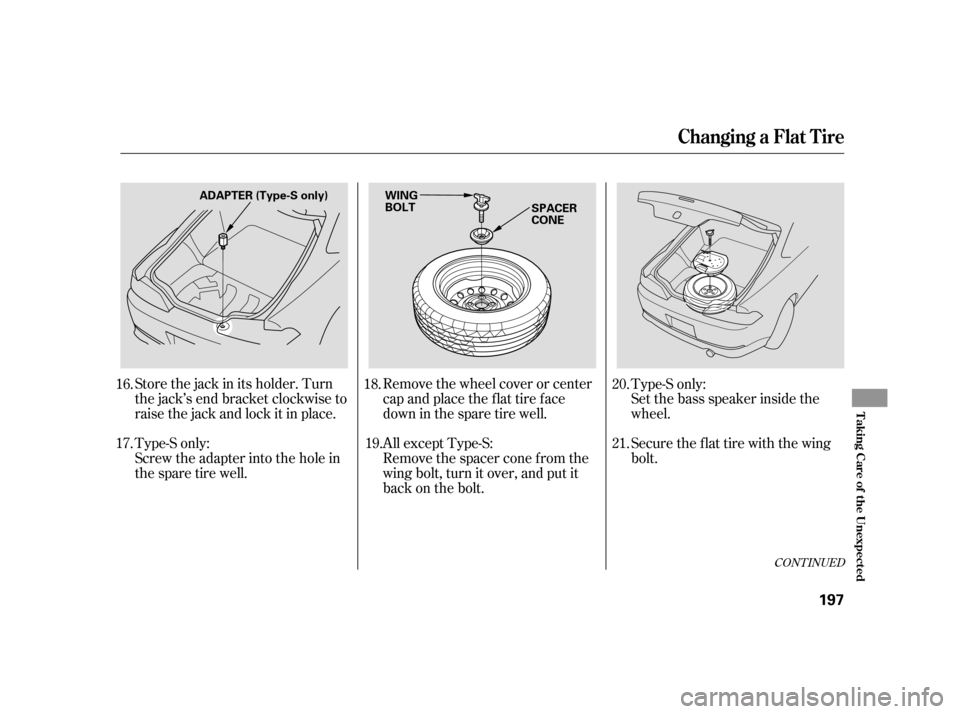spare tire Acura RSX 2005 Owner's Manual
[x] Cancel search | Manufacturer: ACURA, Model Year: 2005, Model line: RSX, Model: Acura RSX 2005Pages: 243, PDF Size: 3.42 MB
Page 152 of 243

Many states and Canadian provinces
require special outside mirrors when
towing a trailer. Even if they don’t,
you should install special mirrors if
you cannot clearly see behind you, or
if the trailer creates a blind spot.
Askyourtrailersalesorrental
agency if any other items are
recommended or required f or your
towing situation.The added weight, length, and
height of a trailer will af f ect your
vehicle’s handling and perf ormance,
so driving with a trailer requires
some special driving skills and
techniques.
Foryoursafetyandthesafetyof
others, take time to practice driving
maneuvers bef ore heading f or the
open road, and f ollow the guidelines
discussed below.
Driveslowerthannormalinall
driving situations, and obey posted
speed limits f or vehicles with trailers.
If you have an automatic
transmission, use D position when
towing a trailer on level roads.
When preparing to tow, and bef ore
driving away, be sure to check the
f ollowing:
The vehicle has been properly
serviced, and the tires, brakes,
suspension, cooling system, and
lights are in good operating
condition.
All weights and loads are within
limits.
Thehitch,safetychains,andany
other attachments are secure.
All items in or on the trailer are
properly secured and cannot shif t
while you drive.
Your vehicle tires and spare are
properly inf lated, and the trailer
tires and spare are inflated as
recommended by the trailer
maker.
CONT INUED
Towing a Trailer
A ddit ional T owing Equipment
T owing Speeds and GearsDriving Saf ely With a T railer
Pre-T ow Checklist
Driving
151
Page 183 of 243

The f ollowing pages give more
detailed inf ormation on how to take
care of your tires and what to do
when they need to be replaced.Keeping the tires properly inf lated
provides the best combination of
handling, tread lif e, and riding
comf ort.
Underinf lated tires wear unevenly,
adversely affect handling and fuel
economy, and are more likely to
fail from being overheated.
Overinf lated tires can make your
vehicleridemoreharshly,are
more prone to damage f rom road
hazards, and wear unevenly.
To saf ely operate your vehicle, your
tires must be the proper type and
size, in good condition with adequate
tread, and correctly inf lated.
We recommend that you visually
check your tires every day. If you
think a tire might be low, check it
immediately with a tire gauge.
Use a gauge to measure the air
pressure in each tire at least once a
month. Even tires that are in good
condition may lose one to two psi (10
to 20 kPa, 0.1 to 0.2 kgf /cm ) per
month. Remember to check the
sparetireatthesametime.
Check the air pressures when the
tires are cold. This means the
vehicle has been parked f or at least
three hours, or driven less than 1
mile (1.6 km). Add or release air, if
needed, to match the recommended
cold tire pressures on the next page.
Inf lation Guidelines
Tires
182
Using tires that are excessively
worn or improperly inflated can
cause a crash in which you can
be seriously hurt or killed.
Follow all instructions in this
owner’s manual regarding tire
inflation and maintenance.
Page 184 of 243

If you check air pressures when the
tires are hot (driven f or several
miles), you will see readings 4 to 6
psi (30 to 40 kPa, 0.3 to 0.4 kgf /cm )
higher than the cold readings. This
is normal. Do not let air out to match
the recommended cold air pressure.
The tire will be underinf lated.
Youshouldgetyourowntire
pressure gauge and use it whenever
you check your tire pressures. This
will make it easier f or you to tell if a
pressure loss is due to a tire problem
and not due to a variation between
gauges.
While tubeless tires have some
ability to self -seal if they are
punctured, you should look closely
for punctures if a tire starts losing
pressure.The following charts show the
recommended cold tire pressures f or
most normal driving conditions and
speeds.
Thecompactsparetirepressureis:(U.S.: Base models, Canada:
Premium models)
(Type-S model)
(Canada: Standard model)
CONT INUED
Tire Size Cold Tire Pressure for
Normal Driving Tire Size Cold Tire Pressure for
Normal Driving
Cold Tire Pressure for
Normal Driving
Tire Size Front:
Rear:
Front:
Rear: Front:
Rear:
Recommended Tire Pressures
Normal Driving
Tires
Maint enance
183
60 psi (420 kPa , 4.20 kgf/cm)
31 psi (220 kPa ,2.2 kgf/cm
)
31 psi (220 kPa , 2.2 kgf/cm
) 31 psi (220 kPa ,
2.2 kgf/cm
)
31 psi (220 kPa , 2.2 kgf/cm
)
31 psi (220 kPa , 2.2 kgf/cm
)
31 psi (220 kPa , 2.2 kgf/cm
)
P215/45R17 87V
P195/65R15 89H P205/55R16 89V
Page 192 of 243

This section covers the more
common problems that motorists
experience with their vehicles. It
gives you inf ormation about how to
safely evaluate the problem and what
to do to correct it. If the problem has
stranded you on the side of the road,
you may be able to get going again.
If not, you will also f ind instructions
on getting your vehicle towed.......................
Compact Spare Tire .192
....................
Changing a Flat Tire .193
.............
If the Engine Won’t Start . 198
................................
Jump Starting .200
..............
If the Engine Overheats . 202
.........
Low Oil Pressure Indicator . 204
..........
Charging System Indicator . 204
.......
Malf unction Indicator Lamp . 205
...............
Brake System Indicator . 206
..................
Closing the Moonroof . 207
..............................................
Fuses .208
..........................
Fuse Locations .211
......................
Emergency Towing .213
Taking Care of the Unexpected
T aking Care of t he Unexpect ed
191
Page 193 of 243

Use the compact spare tire as a
temporary replacement only. Get
your regular tire repaired or replaced,
and put it back on your vehicle as
soon as you can.
Check the inf lation pressure of the
compact spare tire every time you
check the other tires. It should be
inf lated to:
Follow these precautions:Never exceed 50 mph (80 km/h)
under any circumstances.
This tire gives a harsher ride and
less traction on some road sur-
f aces. Use greater caution while
driving. Do not mount snow chains on the
compact spare tire.
Do not use your compact spare
tire on another vehicle unless it is
thesamemakeandmodel.
Replace the tire when you can see
the tread wear indicator bars. The
replacement should be the same size
and design tire, mounted on the
samewheel.Thesparetireisnot
designed to be mounted on a regular
wheel, and the spare wheel is not
designed f or mounting a regular tire.
Compact Spare Tire
192
INDICATOR LOCATION MARK
TREAD WEAR INDICATOR BAR
60 psi (420 kPa , 4.20 kgf/cm)
Page 194 of 243

CONT INUED
If you have a f lat tire while driving,
stop in a saf e place to change it.
Drive slowly along the shoulder until
you get to an exit or an area to stop
that is far away from the traffic lanes.Park the vehicle on f irm, level, and
non-slippery ground. Put the
transmission in Park (automatic)
or Reverse (manual). Apply the
parking brake. If you are towing a
trailer, unhitch the trailer.Turn on the hazard warning lights,
andturntheignitionswitchto
LOCK (0). Have all the
passengers get out of the vehicle
while you change the tire.
Open the hatch. Pull up the f loor
mat and remove the spare tire
cover.
Unscrew the wing bolt.
1. 2.
3.
4.
Changing a Flat T ire
T aking Care of t he Unexpect ed
193
TOOL KIT
JACK
The vehicle can easily roll off
the jack, seriously injuring
anyone underneath.
Follow the directions for
changing a tire exactly, and
never get under the vehicle
when it is supported only by the
jack.
Page 195 of 243

Lift the bass speaker out of the
spare tire and set it aside. Do not
pull on the wiring harness going to
the speaker.
Take the spare tire out of its well.Turn the jack’s end
counterclockwise to loosen it, then
remove the jack.Loosen each wheel nut
1/2turn
with the wheel nut wrench.
5.
6. 7.8.
Type-S only:
Changing a Flat T ire
194
BASS SPEAKER
(Type-S only) JACK
Page 196 of 243

CONT INUED
Place the jack under the jacking
point. Turn the end bracket
clockwise until the top of the jack
contacts the jacking point. Make
sure the jacking point tab is
resting in the jack notch.Remove the wheel nuts, then
remove the flat tire. Place the flat
tire on the ground with the outside
surface facing up.Bef ore mounting the spare tire,
wipeanydirtoff themounting
surface of the wheel and hub with
a clean cloth. Wipe the hub
carefully;itmaybehotfrom
driving.
Use the extension and the wheel
nut wrench as shown to raise the
vehicle until the f lat tire is of f the
ground.
9.
10.
11. 12.
Changing a Flat T ire
T aking Care of t he Unexpect ed
195
JACKING POINT
EXTENSION
WHEEL NUT
WRENCH
Page 197 of 243

Tighten the wheel nuts securely in
the same crisscross pattern. Have
the wheel nut torque checked at
the nearest automotive service
f acility.
Tighten the wheel nuts to:
Put on the spare tire. Put the
wheel nuts back on f inger-tight,
then tighten them in a crisscross
pattern with the wheel nut wrench
until the wheel is f irmly against
the hub. Do not try to tighten
them f ully.
Lower the vehicle to the ground
and remove the jack.
15.
13.
14.
Changing a Flat T ire
196
(Except Type-S)
80 lbf·ft (108 N·m , 11 kgf·m)
Page 198 of 243

Store the jack in its holder. Turn
the jack’s end bracket clockwise to
raisethejackandlockitinplace.
Screw the adapter into the hole in
the spare tire well.Remove the wheel cover or center
cap and place the flat tire face
down in the spare tire well.
Set the bass speaker inside the
wheel.
Secure the f lat tire with the wing
bolt.
Remove the spacer cone f rom the
wing bolt, turn it over, and put it
back on the bolt.
18.
16.
17. 20.
21.
Type-S only: Type-S only:
19.All except Type-S:
CONT INUED
Changing a Flat T ire
T aking Care of t he Unexpect ed
197
ADAPTER (Type-S only) WING BOLTSPACER
CONE